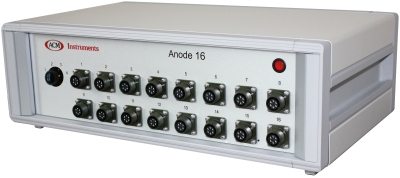|
Applications:
Standards:
Features:
|
Anode 16 with 4-day switch |
|
The Anode 16 is a new device from ACM Instruments. This instrument is used to determine the potential and current carrying capacity of alloys used for cathodic protection. It provides an easily used and reliable method of screening batches of anodes to ensure performance consistency for batch to batch. Tell us which standard(s) you use for testing in your organisation and we build the instrument to suit. For example if you prefer testing to DNV-RP-B401 (which is the most popular) then you will test the samples for 4 days at different currents per day. The software will log the current, coulombs, and potentials and alert the technician when to change the current via the simple rotary day switch on the front panel. We avoid using digital to analogue converters in our long term equipment to eliminate the real possibility of the digital converters setting the wrong value after a power cut (and destroying the test), hence the rotary day switch. The other part of the test is a long term (> 12 months) soak with an impressed current of up to 1 mA / cm2, measuring current and voltage during the test. A typical Anode 16 for this test would have 4 channels dedicated to the short 4 day test allowing for many electrodes to be connected in series. A reference electrode input measures the potential at three points on each sample at the end of the test. This is done by manually moving a Luggin probe to within 1 mm of the sample and pressing the log key. The potential is saved and associated with the electrode within the ACM software. The long term part of the test is taken care of by 12 galvanic channels each driving up to 250 mA. Other laboratories might only use the 4-day short test. In this case 16 channels of galvanostatic control, each with the 4 day switch could be specified. The design philosophy behind these new instruments is to provide a simple reliable way to perform standard tests on batches of anodes. The instrument must carry on immediately after power cuts and not be effected by computer problems and glitches, that’s why we ditched the DAC, so there is no destructive current flowing from the galvanostat after the computer is rebooted. The simplicity of the Anode 16 make mistakes much less likely than using discrete power supplies, current sources, multimeters and pen and paper. These mistakes cost money and time and require senior staff to be involved. Our Anode 16 allows new technicians to start testing with minimal training, saving time, improving reliability and keeping a proper log of all test results. Contact ACM today and talk to Andrew who will quickly prepare a detailed quotation to your requirements. |
|

